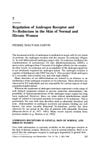Mechanisms of Testosterone Action
January 2021
TLDR Testosterone works in different ways, including direct interaction with its receptor, conversion to other hormones for specific effects on genitalia, hair, bones, and muscle, and changes in body fat and sexual function when low.
The document from January 1, 2021, explains that testosterone operates through multiple pathways: it can directly interact with the androgen receptor, be converted to Dihydrotestosterone (DHT) by the enzyme 5-alpha reductase in certain tissues, or be transformed into estradiol by aromatase to act on the estrogen receptor. Testosterone's conversion to DHT is essential for its effects on external genitalia, including the prostate gland, and sexual hair, while its conversion to estradiol is crucial for its influence on bone. In males with hypogonadism, levels of both androgen and estrogen are decreased, leading to a reduction in lean mass, muscle size, and strength due to androgen deficiency, and an increase in body fat and a decline in sexual function due to both androgen and estrogen deficiency.

